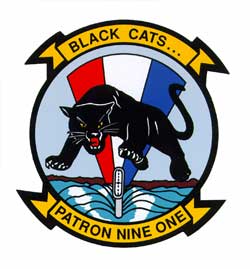| Patrol Squadron 91 | |
|---|---|
 VP-91 patch | |
| Active | 1 November 1970 - 31 March 1999 |
| Country | United States of America |
| Branch | |
| Type | squadron |
| Role | Maritime patrol |
| Nickname(s) | Pink Panthers Stingers Black Cats |
| Engagements | Gulf War |
| Aircraft flown | |
| Patrol | P-3A/B/C Orion |
Patrol Squadron 91 (VP-91) was a patrol squadron of the U.S. Naval Reserve. It was the second squadron to bear the VP-91 designation, the first VP-91 was redesignated VPB-91 on 1 October 1944. The squadron was established on 1 November 1970 and deactivated 29 years later, on 31 March 1999. It flew the Lockheed P-3 Orion, and was based at NAS Moffett Field during its entire life. The squadron's nicknames were the Pink Panthers from 1970 to 1984, the Stingers from 1984 to 1991, and the Black Cats from 1991 to 1999. Units of the squadron made 25 major overseas deployments. [1]

